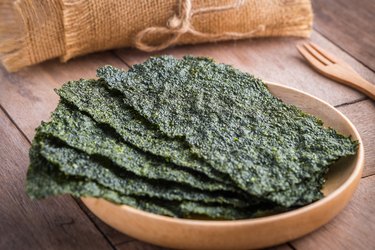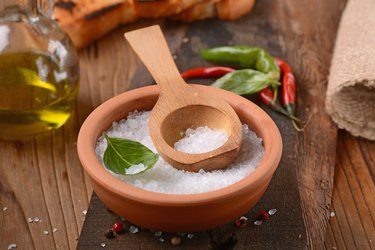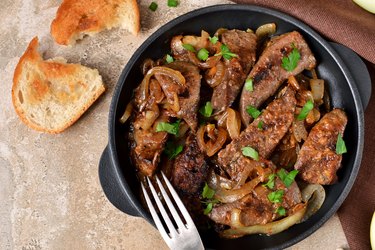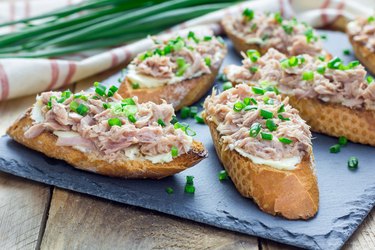If you've ever studied a salt label and wondered what "iodized" means, keep reading.
Iodine is an important mineral that plays a key role in maintaining thyroid function, according to the National Institutes of Health (NIH). A healthy thyroid is important for your body's metabolism, as well as bone and brain development during pregnancy, according to the NIH.
Video of the Day
Video of the Day
How Much Iodine Do You Need Per Day?
Adults need 150 micrograms of iodine per day, according to the NIH. Infants and children need 130 and 90 micrograms per day, respectively, while pregnant and breastfeeding people need 220 and 290 micrograms per day, respectively.
Not many foods are naturally high in iodine, which is why the mineral is often added to salt, aka iodized salt. Try to opt for iodized salt in your home cooking to avoid a deficiency — especially if you're on a vegan diet or are pregnant as these groups are more prone to being deficient, per the NIH.
Read on to find out what foods are high in iodine. Note that the FDA calculates its Daily Value (DV) percentages based on eating 150 micrograms of iodine per day.
1. Dried Seaweed: 150% Daily Value (DV)

While there aren't many vegetables high in iodine, seaweed is an exception, with 232 mcg or 150 percent of your DV per 10-gram serving, about 10 sheets of dried seaweed. (We don't expect you to nosh on a handful of wet, slimy seaweed the next time you're at the beach, by the way.)
Dried Nori seaweed is a thin, flaky and tasty snack that provides other important nutrients, including potassium, vitamins A and C, and plant-based zinc. Other types of edible seaweed high in iodine include kombu.
Tip
There aren't any foods high in iodine to avoid with hyperthyroidism (overactive thyroid). You can still eat seaweed if you have hyperthyroidism, but you should avoid kelp supplements because they contain a high concentration of the mineral, per the Cleveland Clinic.
2. Iodine-Enriched Bread: 132% DV
Breads and cereals are often fortified with vitamins and minerals, especially those that aren't usually found in plant-based foods, including vitamin B12. Some breads are fortified with iodine — the ingredient list will read "potassium iodate" or "calcium iodate."
Iodine-enriched bread has around 198 mcg or 132 percent of the DV for iodine per slice. Whole-wheat bread is better for you thanks to its whole grains, which are rich in gut-healthy fiber.
3. Cod: 106% DV
Seafood and fish top many food charts when it comes to high levels of good-for-you nutrients. Cod absorbs iodine from seawater and the food it eats, which is why it's an iodine-rich food, according to a May 2018 study in Food and Nutrition Research.
A 3-ounce cooked serving has 158 mcg or 108 percent of the DV for iodine. Cod is also a good source of protein, omega-3 fatty acids and vitamin B12.
4. Yogurt: 77% DV
Dairy foods, including yogurt, are the primary food source for iodine in the United States, according to the NIH. A 1-cup serving of non-fat Greek yogurt gives you 116 mcg or 77 percent of the DV for iodine.
Greek yogurt is also an excellent source of protein and contains probiotics, aka healthy bacteria that keep your gut and immune system running smoothly, according to the Cleveland Clinic. Try it in these protein-rich Greek yogurt dinner recipes.
5. Milk: 57% DV
Another iodine-rich dairy food is milk. There's 85 mcg or 57 percent of your DV of iodine in milk (per cup).
And FYI, it's not always prudent to avoid fat in milk — dietary fat is satiating and helps your body absorb vitamins A, D, E and K (milk is fortified with vitamin D). Plus, the saturated fat in dairy might not be as bad as we once thought. Certain dairy fats are not associated with death or heart disease, per a July 2018 study in the American Journal of Clinical Nutrition.
6. Iodized Salt: 51% DV

A 1/4 teaspoon of iodized salt contains 76 mcg or 51 percent of the DV for iodine as well as 575 milligrams of sodium. That's not to say you should dump iodized salt on all of your food — a diet high in sodium can raise blood pressure, a huge risk factor for heart disease and stroke, per the Centers for Disease Control and Prevention.
But buying iodized salt over other types, and using it sparingly, can help you avoid a deficiency. The Dietary Guidelines for Americans recommend limiting your daily sodium intake to no more than 2,300 milligrams (about 1 teaspoon).
Beans are a versatile iodine-rich food that's vegan. A 1-cup serving of cooked navy beans contains 64 mcg or 42 percent of the DV for iodine as well as plant-based protein, iron and fiber. Try it in these healthy canned bean recipes.
8. Baked Potato: 40% DV
Baked potatoes aren't just boring side dishes — they are a good source of energizing carbs including fiber. Plus, one medium baked potato has 60 mcg or 40 percent of the DV for iodine. Add a dash of iodized salt and top with veggies and melted cheese for a nutrient-rich meal.
9. Fish Sticks: 39% DV
If you were looking for a reason to tap into your inner child, fish sticks are one way to go. Most fish sticks are made with a white fish, like cod, which is a good source of iodine.
A 3-ounce serving of fish sticks provides 58 mcg or 39 percent of the DV for iodine. Another bonus: White fish tend to have lower levels of mercury than larger fish, including tuna.
10. Turkey Breast: 23% DV
Baked turkey breast provides high-quality protein and vitamin B12 as well as 34 mcg or 23 percent of the DV for iodine per 3-ounce serving.
Turkey breast, the white part of the meat, contains less saturated fat than dark meat, like the thigh. Saturated fat should be limited to less than 10 percent of your daily total calories, per the U.S. National Library of Medicine. Skip the dry bird with these easy and delicious turkey recipes.
11. Eggs: 17% DV
Eggs are one of the most nutrient-dense foods. In just one hard-boiled egg, you'll get nearly a quarter of the DV — 26 mcg or 17 percent — for iodine and more than 6 grams of protein. Try one of these creative egg recipes that pack a nutritional punch.
12. Beef Liver: 9% DV

Organ meats, like beef liver, top the charts when it comes to certain nutrients, including iron, B vitamins and vitamin A. Per a 3-ounce serving, beef liver also offers 14 mcg or 9 percent of the DV for iodine.
13. Cheddar Cheese: 9% DV
As if you needed any more reasons to eat cheese! Cheddar cheese provides 14 mcg or 9 percent of the DV for iodine per 1-ounce serving.
It's also an excellent source of bone-building calcium, deeming it a good-for-you snack. Or, try one of these healthy-ish gooey, grilled cheese recipes.
14. Shrimp: 9% DV
Shrimp, like most seafood, is a healthy, low-calorie food that serves up protein and vitamin B12. A 3-ounce serving of cooked shrimp also contains 13 mcg or 9 percent of the DV for iodine as well as heart-healthy omega-3 fatty acids.
15. Canned Tuna: 5% DV

While tuna is known for its high levels of mercury, canned light tuna tends to be lower in levels of the toxin, according to the Environmental Defense Fund.
A 3-ounce serving of canned tuna contains 7 mcg or 5 percent of the DV for iodine as well as protein, potassium and vitamin B6. Plus, it's easy to prepare in sandwiches, salads and these tasty tuna recipes.
- National Institutes of Health (Consumer): "Iodine"
- National Institutes of Health: "Iodine"
- Food and Nutrition Research: "Iodine Content of Six Fish Species, Norwegian Dairy Products and Hen’s Egg"
- Cleveland Clinic: "Probiotics"
- American Journal of Clinical Nutrition: "Serial Measures of Circulating Biomarkers of Dairy Fat and Total and Cause-specific Mortality in Older Adults: The Cardiovascular Health Study"
- Centers for Disease Control and Prevention: "Sodium"
- U.S. Food and Drug Administration: "Sodium in Your Diet"
- American Cancer Society: "American Cancer Society Guideline for Diet and Physical Activity"
- U.S. National Library of Medicine: "Facts About Saturated Fat"
- Environmental Defense Fund: "Mercury Alert: Is Canned Tuna Safe?"